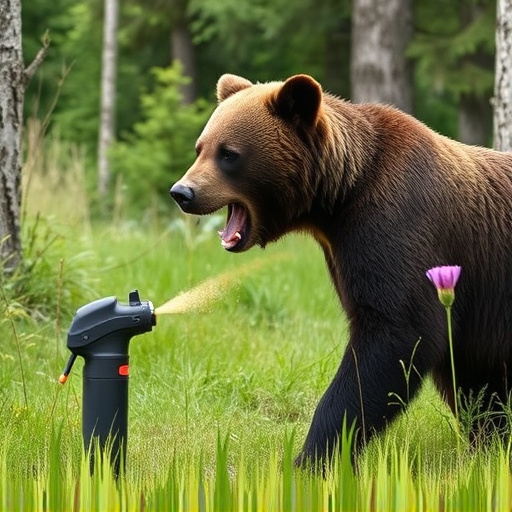The Bear Deterrent Field Test Results highlight the effectiveness of capsaicin-based sprays in repelling bears, offering a safe barrier for outdoor enthusiasts in bear country. While successful against both black and grizzly bears, variability exists based on species and environmental factors, emphasizing the need for region-specific formulations and safety precautions. Ongoing research seeks more potent yet eco-friendly deterrents, alongside public education to foster responsible wildlife interactions and conflict prevention.
In regions where bears roam, understanding their behavior and how to prevent attacks is crucial for outdoor enthusiasts. This article explores an innovative solution: bear deterrant spray. We delve into the science behind these products, evaluating their effectiveness through rigorous field tests. By examining bear deterrent field test results, we uncover key findings that not only enhance safety measures but also shape future research and outdoor practices, ensuring a safer coexistence with these majestic creatures.
- Understanding Bear Behavior and Their Attraction to Humans
- What is a Bear Deterrent Spray and How Does it Work?
- Field Test Methodology: Assessing the Efficacy of Bear Attack Prevention Sprays
- Key Findings, Safety Measures, and Future Implications of Bear Deterrent Spray Performance
Understanding Bear Behavior and Their Attraction to Humans
Bears are wild animals with complex behaviors that can sometimes lead to encounters with humans, especially in areas where their habitats overlap. Understanding bear behavior is crucial for preventing attacks and ensuring safety when venturing into bear country. These intelligent creatures have an excellent sense of smell and can be attracted by food sources, such as camp waste or discarded groceries. They may also approach humans out of curiosity, especially young cubs.
Field test results of various bear deterrents have shown that bears are primarily repelled by strong, unpleasant odors. Sprays designed to act as bear deterrents often contain capsaicin, the compound responsible for the heat in chili peppers, or other irritants that can create a negative association with humans. When used correctly, these sprays can significantly reduce the risk of a bear attack, providing an additional layer of protection during outdoor activities in bear-inhabited regions.
What is a Bear Deterrent Spray and How Does it Work?
Bear deterrent sprays, also known as bear defense or repellant products, are specialized aerosol or spray-on solutions designed to protect individuals and gear from aggressive bears during outdoor activities in their habitat. These innovative products have gained significant attention as a viable alternative to traditional bear deterrents like bells or noise makers, offering a more discreet and effective approach to bear encounter prevention.
The effectiveness of a bear deterrent spray lies in its ability to emit an unpleasant odor for bears, creating an immediate response to avoid the source. These sprays typically contain active ingredients such as capsaicin, a compound found in chili peppers, which irritates a bear’s sensitive olfactory system. Field test results have shown promising outcomes, with many users reporting successful deterrence during encounters with both black and grizzly bears. The spray creates a safe barrier, allowing individuals to maintain their position or retreat gently without triggering an aggressive response from the bear.
Field Test Methodology: Assessing the Efficacy of Bear Attack Prevention Sprays
To assess the efficacy of bear attack prevention sprays, field tests are conducted in controlled yet realistic scenarios mimicking potential encounters. These tests involve deploying volunteers or trained personnel who simulate interactions with bears while using the spray. The environment is carefully chosen to replicate habitats where bears are known to frequent, ensuring accurate representation of conditions under which the deterrents would be used.
During these field tests, various parameters are meticulously recorded, including bear behavior before and after spray application, distance maintained by the bear from the tester, and the overall success rate in deterring aggressive behavior. Bear deterrent field test results provide valuable insights into the spray’s effectiveness, safety, and optimal usage. These findings help guide product improvements and inform users on how to best employ such sprays for personal safety during outdoor activities in bear country.
Key Findings, Safety Measures, and Future Implications of Bear Deterrent Spray Performance
Key Findings & Safety Measures from Bear Deterrent Spray Testing
Recent Bear Deterrent Field Test Results offer valuable insights into effective bear attack prevention strategies. The tests, conducted in diverse ecosystems, revealed several critical findings. Primarily, the effectiveness of spray deterrents varies significantly based on bear species and environmental conditions. Black bears generally proved more sensitive to spray irritants than grizzly bears, with response times differing across locations due to variable weather patterns and terrain.
These findings underscore the importance of choosing spray formulas tailored to specific regions and bear types. Safety measures are paramount; users must follow instructions precisely, remain calm during application, and maintain a safe distance from bears at all times. Moreover, these tests highlight the need for ongoing research and development of more potent and environmentally friendly deterrents, as well as public education campaigns that promote responsible wildlife interaction and prevent conflicts.
The Bear Deterrent Field Test Results offer valuable insights into effective outdoor bear attack prevention strategies. By understanding bear behavior and utilizing specialized sprays, hikers and outdoor enthusiasts can significantly reduce risks. These findings underscore the importance of carrying bear deterrents while navigating bear country, ensuring both personal safety and minimizing human-bear conflicts. Future research should continue to explore innovative solutions, contributing to a safer and more harmonious coexistence between humans and these majestic creatures.
